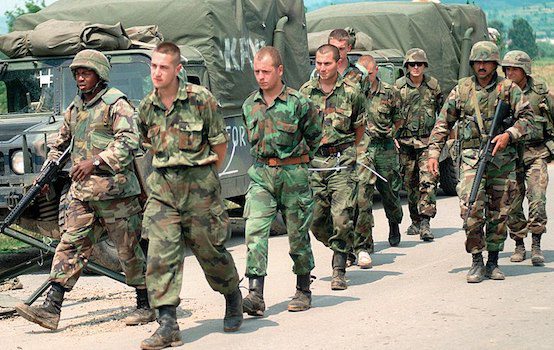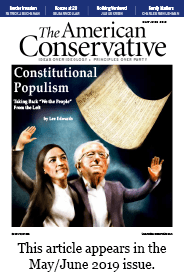The Kosovo War at 20

This is a year of major European milestones. In April, NATO turned 70, to subdued celebrations in Washington and questions about the alliance’s continued relevance. June will mark the centennial of the Treaty of Versailles, a rending of empires that provided only a brief respite from world war. November will see the 30th anniversary of the fall of the Berlin Wall.
Lost in these commemorations is the 20th anniversary of a brief, minor war. NATO began dropping bombs on Serbian forces in Kosovo on March 24, 1999. This three-month bombing campaign in the Balkans is an afterthought to most Americans today, a distant memory after the last two decades of ceaseless war around the Greater Middle East. Even at the time, Kosovo’s victors didn’t try too hard to inflate their accomplishment. When it was over, General Wesley Clark, Supreme Allied Commander Europe and the war’s director, admitted that, “This was not, strictly speaking, a war.”
Kosovo’s veterans, none of whom died in action, won’t receive a spot on the National Mall. Yet the Kosovo War is worth reflecting on as a harbinger of many key features of America’s post-9/11 foreign policy—the era of forever war.
America and NATO went to war in Kosovo for humanitarian reasons. There was no vital national interest at stake. The Serbs, already responsible for the lion’s share of the atrocities during the Bosnian war, were to be punished and deterred from further mass killings in their restive, majority-Albanian province of Kosovo. Proponents of intervention compared ethnic cleansing in Kosovo to the Holocaust, sometimes inflating the death counts of Serbian atrocities by a factor of 10. That the ethnic Albanian Kosovo Liberation Army was considered “without any questions, a terrorist group” by President Bill Clinton’s own special envoy to the Balkans was hand-waved away.
Kosovo gave birth to the idea of the responsibility to protect—“R2P” in international relations shorthand. R2P cast aside the Westphalian state system by declaring that when a government proved unwilling or unable to protect its people from crimes against humanity, it was the duty of other nations to intervene. British Prime Minister Tony Blair declared that Kosovo was “a battle between good and evil; between civilization and barbarity.” Established during America’s decade of unipolarity and hyperpower status, R2P thus implicitly called on America to be a force of intervention for global good.
Proponents of this doctrine unabashedly cast aside state sovereignty for the sake of humanitarianism. As would later come in Iraq, with no United Nations Security Council mandate, the war’s backers proclaimed that it had “legitimacy if not legality,” an argument that would be repeated a few years later in Iraq. R2P was celebrated by internationalists and interventionist human rights activists. After sitting on its hands for too long in Bosnia, America was now acting swiftly to prevent a potential genocide in Europe. At home as abroad, that “moral arc of the universe” was bending toward justice.

Putatively liberal pundits and politicians, thrilling to this idea of America as global cop on the beat, were at the forefront of the push for war on Serbia in 1999. Christopher Hitchens, seeing in Kosovo both “Serbia’s Gaza” and “another Rwanda in the making,” celebrated as the bombs dropped. Michael Ignatieff, the peripatetic Canadian academic and politician, urged intervention to counter “the worst political crime in Europe since 1945.” (One wonders: why does Canada continually send their warmongers south? Is it payback for the rich harvest of Canadian comics that America regularly reaps?)
Both men would resume the cheerleading for war a few years later, when the public relations campaign for the Iraq war began to spin up. Their ideological children are with us still: the Anne-Marie Slaughters and Richard Haases of the world, unwilling to contemplate reality in Afghanistan or Syria so long as a girls school can be saved or a recalcitrant minority group armed and assured of American aid.
♦♦♦
R2P proponents helped carry water for America’s disastrous wars in Iraq and Libya. R2P was not explicitly used by the Bush administration when it made the case for invading Iraq, but humanitarianism and Saddam Hussein’s undeniable brutality were used as rhetorical cudgels against those who dissented from this war of choice. In Libya, R2P was the casus belli. Intervention was explicitly and indeed solely justified by the responsibility to protect Libyan civilians in Benghazi from the coming wrath of dictator Muammar Gaddafi. Of course, the goal posts were quickly moved, as NATO airpower helped the rebels to win the civil war and Gaddafi was murdered in the street. Libya sank into further strife, with militias battling in the cities, foreign militants flooding in, and even slave markets appearing.
In Syria, humanitarian concerns only led the United States to arm jihadis and conduct a few feckless cruise missile strikes, rather than launch a full-scale invasion of yet another Arab country. One of the primary architects and apostles of R2P, then-UN ambassador Samantha Power, was left to sputter and rage about the atrocities of one side in the civil war.
The Kosovo campaign exposed the hollow force that NATO had become less than a decade after the end of the Cold War. All Western nations rightly took a peace dividend after the Soviet Union collapsed and the fearsome Red Army became the farcical Russian Army that (initially) couldn’t even subdue tiny Chechnya. The Europeans cut far more deeply than the United States, however. The vaunted Royal Air Force nearly ran out of bombs and spare parts in Kosovo. U.S. aircraft ended up conducting about two thirds of all sorties during the 78-day war and carried far more of the load in the early days of the campaign. Eighty-three percent of all munitions dropped were American.
American generals were unpleasantly surprised by the state of NATO air assets. The European NATO states were most lacking in the most critical capabilities: ISR (intelligence, surveillance, and reconnaissance) and strike. Secretary of Defense Donald Rumsfeld initially rejected European assistance in the wake of the September 11 attacks, so struck was he by European military impotence in Kosovo two years prior.
The limits of NATO’s smart bombs and precision strike capabilities also became clear in Kosovo. Despite overwhelming technological superiority, including the first combat use of the B-2 Spirit stealth bomber and the now standard GPS-guided Joint Direct Attack Munition, coalition attrition of Serbian forces turned out to have been more limited than early reports indicated. Poor weather, Serb cunning, and legacy air defense capabilities combined to limit the air campaign’s effect on Serbian materiel. The Serbs built dummy tanks with wood, plastic sheeting, and camouflage netting; metal plates and even hot water were used to spoof NATO thermal sensors. It took NATO the first 12 days to conduct the same number of strike sorties that the U.S.-led coalition had achieved during the first 12 hours of Operation Desert Storm. When Serbian troops withdrew from Kosovo at the end of the campaign, they left in good order, having suffered perhaps 20 percent of the casualties the coalition had originally claimed to have inflicted.
NATO’s material inadequacies were matched by a lack of will. European member states demurred from an aggressive U.S. plan to bomb Belgrade from the outset, likely prolonging the air war. When they did sign on to a broader air campaign, European leaders insisted on micromanaging the target list, in the manner of President Johnson in Vietnam 30 years before. This centralization, risk aversion, and fixation on preventing civilian casualties would become familiar to those who served with NATO troops in Afghanistan a few years later.
Americans were right behind Europeans in risk aversion, however. Much of the indecisiveness of the air campaign was due to keeping NATO planes at high altitude to avoid the remaining Serbian air defense assets. Decoy tanks and dummy artillery pits were much tougher to spot at 15,000 feet than at 500. No pilots in body bags trumped operational effectiveness and decisive victory.
The biggest legacy of the Kosovo war came in its immediate aftermath. Russia had tried to position itself between its Western economic benefactors and its traditional Serbian ally. Russian mediation offers were rejected by the U.S., and air strikes on Belgrade inflamed Russian public opinion. Even Boris Yeltsin, who owed his reelection in 1996 to U.S. intervention (the original, reverse Russiagate), could not stand for this level of shame.
When Serbia capitulated, Russian troops rushed into Kosovo from neighboring Bosnia to seize the airport in the capital, Pristina. Elite Norwegian and British troops met the Russians at the airfield, but General Clark insisted on trying to block the runway to stymie Russian attempts to reinforce their 250-man company at Pristina. His more level-headed British subordinate, General Mike Jackson, refused to carry out Clark’s orders and reportedly told the hyper-ambitious Arkansan, “I’m not going to start the Third World War for you.” Cooler heads prevailed, no shots were fired, and Clark left his post early, headed for eventual irrelevance in the 2004 Democratic presidential primary. But the ailing and humiliated Yeltsin resigned six months later, giving the Russian presidency to Vladimir Putin.
The war had left Kosovo as an autonomous region of Yugoslavia and then Serbia, policed by NATO’s Kosovo Force (KFOR). But Serbia’s continuing authority over Kosovo was still internationally recognized. The Kosovars, frustrated with the pace of final status negotiations, unilaterally declared independence on February 17, 2008. The international community was and is divided on recognizing Kosovo’s sovereignty, but Russia’s reaction was unequivocal. Vladimir Putin described the recognition of Kosovo’s independence by the U.S. and many European nations as “a terrible precedent, which will de facto blow apart the whole system of international relations, developed not over decades, but over centuries.” He warned the West: “they have not thought through the results of what they are doing. At the end of the day it is a two-ended stick and the second end will come back and hit them in the face.”
Putin explicitly invoked Kosovo after his incursion into Georgia in 2008 and his annexation of Crimea in 2014. Speaking to the Russian State Duma on March 18, 2014, Putin quoted America’s April 2009 Written Statement to the UN International Court in support of Kosovo’s independence, and asked what made Kosovo a special case. He told the Duma’s deputies, “This is not even double standards; this is amazing, primitive, blunt cynicism. One should not try so crudely to make everything suit their interests, calling the same thing white today and black tomorrow.” Turnabout is fair play. America’s ill-considered endorsement of Kosovo’s independence not only deepened tensions with Russia, it quickly provided justification for Russian land grabs and wars on both sides of the Black Sea.
Regardless of America’s laudable intentions and aims, the Kosovo war proved a handmaiden of two decades of disastrous interventions abroad. American hyperpower hubris, set free in a tiny corner of the Balkans, would unleash far more disastrous interventions in far more important regions of the world. Then-secretary of state James Baker had said of Yugoslavia in 1991, “We don’t have a dog in that fight.” Since Kosovo, America has found fights wherever it looked for them.
Gil Barndollar is Director of Middle East Studies at the Center for the National Interest and Military Fellow-in-Residence at the Catholic University of America’s Center for the Study of Statesmanship.